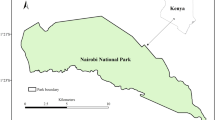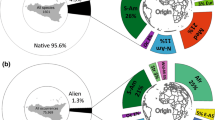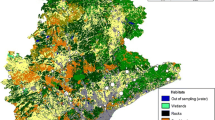Abstract
Although biological invasion by alien species is a major contributor to loss of indigenous biological diversity, few studies have examined the susceptibility of the boreal biome to invasion. Based on studies of other ecosystems, we hypothesized that alien plants will be restricted to disturbed areas near human activity and will not be found in natural areas of boreal ecosystems in Gros Morne National Park (Canada), a protected area experiencing a wide range of disturbance regimes. The distribution of alien plants in the region was evaluated using surveys, and study sites were established in naturally and anthropogenically disturbed habitats that had been invaded. Within study sites, randomization tests evaluated the importance of disturbance to alien plant invasion by examining changes in environmental conditions and species abundance within various disturbance regimes, while the importance of site characteristics limiting the distribution of alien plants were examined using Canonical Correspondence Analysis. Consistent with studies in a variety of biomes, areas of high disturbance and human activity had the greatest abundance of resources and the highest percentage of alien species. However, contrary to our hypothesis, natural areas of boreal ecosystems were found susceptible to alien plant invasion. Vegetation types vulnerable to invasion include forests, riparian areas, fens, and alpine meadows. Natural disturbance occurring in these vegetation types caused increases in bare ground and/or light availability facilitating alien plant invasion. Although high soil pH was associated with alien plants in these areas, disturbance was not found to cause changes in soil pH, suggesting susceptibility to invasion is pre-determined by bedrock geology or other factors influencing soil pH. Moose (Alces alces), a non-native herbivore, acts as the primary conduit for alien plant invasion in GMNP by dispersing propagules and creating or prolonging disturbance by trampling and browsing vegetation. The recurrent nature of disturbance within the boreal biome and its interaction with site conditions and herbivores enables alien plants to persist away from areas of high human activity. Managers of natural lands should monitor such interactions to decrease the invasion potential of alien plants.





Similar content being viewed by others
References
Baker HG (1965) Characteristics and modes of origin of weeds. In: Baker HG, Stebbins GL (eds) The genetics of colonizing species. Academic Press, New York
Bazzaz FA (1983) Characteristics of populations in relation to disturbance in natural and man-modified ecosystems. In: Mooney HA, Godron M (eds) Disturbance and ecosystems: components of response. Ecological studies, vol 44. Springer, Berlin Heidelberg New York
Bengtsson L, Enell M (1986) Chemical analysis. In: Baglund BE (eds) Handbook of holocene paleoecology and paleohydrology. Wiley, New York
Benninger-Traux M, Vankat JL, Schaefer RL (1992) Trail corridors as habitat and conduits for movement of plant species in Rocky Mountain National Park, Colorado, USA. Landscape Ecol 6:269–278
Berger AR (Coordinator), Bouchard A, Brookes IA, Grant DR, Hay SG, Stevens RK (1992) Geology, topography, and vegetation, Gros Morne National Park, Newfoundland. Misc. Report. Map 1:150,000. Geological Survey of Canada, Ottawa, ON
Bouchard A, Hay SG, Bergeron Y, Leduc A (1991) The vascular flora of Gros Morne National Park, Newfoundland: a habitat classification approach based on floristic, biogeographical, and life-form data. In: Nimis PL, Covello TJ (eds) Quantitative approaches to phytogeography. Kluwer Academic, The Netherlands
Brothers TS, Spingarn A (1992) Forest fragmentation and alien plant invasion of central Indiana old-growth forests. Conserv Biol 6:91–100
Brouillet L, Hay S, Bouchard A (1996) Biodiversity of Gros Morne National Park: rare vascular plant distribution and conservation. In: Anions DW, Berger AR (eds) Assessing the state of the environment of Gros Morne National Park. National Parks and Historic Sites, Halifax, pp 69–73
Burke MJ, Grime JP (1996) An experimental study of plant community invasibility. Ecology 77:776–790
Carson WP, Pickett STA (1990) Role of resources and disturbance in the organization of an old-field plant community. Ecology 71:226–238
Cooper K (1981) Alien anthropogenic vegetation of the Avalon Peninsula. In: Macpherson J, Macpherson A (eds) The natural environment of Newfoundland: past and present. Department of Geography, Memorial University. St. John’s, NL
D’Antonio CM (1997) Introduction. In: Luken JO, Thieret JW (eds) Assessment and management of plant invasions. Springer, Berlin Heidelberg New York
D’Antonio CM, Vitousek PM (1992) Biological invasions by exotic grasses, the grass/fire cycle, and global change. Annu Rev Ecol Syst 23:63–87
Davis MA, Grime JP, Thompson K (2000) Fluctuating resources in plant communities: a general theory of invasibility. J Ecol 88:528–534
Elliot-Fisk D (2000) The boreal forest. In: Barbour MG, Billings WD (eds) North American terrestrial vegetation. Cambridge University Press, New York
Fernald ML (1950) Gray’s manual of botany, 8th edn. A handbook of the flowering plants and ferns of central and northeastern United States and adjacent Canada. Dioscorides, Portland, Ore.
Fox MD, Fox BJ (1986) The susceptibility of natural communities to invasion. In: Groves RH, Burdon JJ (eds) Ecology of biological invasions. Cambridge University Press, Cambridge
Grime JP (1979) Plant strategies and vegetation processes. Wiley, Chichester
Grime JP, Hodgson JG, Hunt R (1988) Comparative plant ecology: a functional approach to common British species. Unwin Hyman, London
Harrison S (1999) Native and alien species diversity at the local and regional scales in a grazed California grassland. Oecologia 121:99–106
Hendrickson C (2000) Biogeography of coltsfoot (Tussilago farfara L.) invasion in Gros Morne National Park, Newfoundland. Masters thesis, Department of Geography, Memorial University, St. John’s, NL
Hobbs RJ (1989) The nature and effects of disturbance relative to invasions. In: Drake JA, Mooney HA, di Castri F, Groves RH, Kruger FJ, Rejmanek M, Williamson M (eds) Biological invasions: a global perspective. Wiley, New York
Hutchinson TF, Vankat JL (1997) Invasibility and effects of Amur Honeysuckle in Ohio Forests. Conserv Biol 11:1117–1124
Kolar CS, Lodge DM (2001) Progress in invasion biology: predicting invaders. Trends Ecol Evol 16:199–204
Kourtev PS, Ehrenfeld JG, Huang WZ (1998) Effects of exotic plant species on soil properties in hardwood forests of New Jersey. Water Air Soil Pollut 105:493–501
Larson DL, Anderson PJ, Newton W (2001) Alien plant invasion in mixed-grass prairie: effects of vegetation type and anthropogenic disturbance. Ecol Appl 11:128–141
Mack MC, D’Antonio CM (1998) Impacts of biological invasions on disturbance regimes. Trends Ecol Evol 13:195–198
Meades SJ, Hay SG, Brouillet L (2000) Annotated checklist of the vascular plants of Newfoundland and Labrador. Department of Forest Resources and Agrifoods, St, John’s, NL
Mehlich A (1984) Mehlich III soil test extractant: a modification of II extractant. Commun Soil Sci Plant Anal 15:1409–1416
Parks Canada Agency (2000) Unimpaired for future generations? Protecting ecological integrity with Canada’s national parks, vol II. Setting a new direction for Canada’s national parks. Report of the Panel on the Ecological Integrity of Canada’s National Parks, Ottawa, ON
Pastor J, Mladenoff DJ (1992) The southern boreal-northern hardwood forest border. In: Shugart HH, Leemans R, Bonan GB (eds) A systems analysis of the global boreal forest. Cambridge University Press, Cambridge
Pielou EC (1988) The world of northern evergreens. Cornell University Press, Ithaca, New York
Planty-Tabacchi A-M, Tabacchi E, Naiman RJ, Deferrari C, Decamps H (1996) Invasibility of species-rich communities in riparian zones. Conserv Biol 10:598–607
Pysek P, Prach K (1993) Plant invasions and the role of riparian habitats: a comparison of four species alien to central Europe. J Biogeogr 20:413–420
Randall J (2001) A general theory of invasibility. The Newsletter of the Invasive Plant Council of New York State 3. Number 1. Invasive Plant Council, New York
Rose MD (1998) Distribution and abundance of exotic plant species in Terra Nova National Park. Honours Thesis, Department of Biology, Memorial University, St. John’s, NL
Rose MD (2002) Are boreal ecosystems susceptible to invasion by alien plants? A case study of Gros Morne national park. Masters Thesis, Department of Biology, Memorial University, St. John’s, NL
Schnieder DC, Hendry CI (1996) Biology 4605: laboratories in quantitative biology. Memorial University. St. John’s, NL
Shugart HH, Leemans R, Bonan GB (1992) A systems analysis of the global boreal forest. Cambridge University Press, Cambridge
Sokal RR, Rohlf FJ (1995) Biometry, 3rd edn. Freeman, New York
Stapleton CA, McCorquodale DB, Sneddon C, Williams M, Bridgeland J (1998) The distribution and potential for invasiveness of some non-native vascular plants in Northern Cape Breton. Parks Canada Technical Reports in Ecosystem Science, No. 15. Parks Canada, Halifax, NS
Stohlgren TJ, Bull KA, Otsuki Y, Villa CA, Lee M (1998) Riparian zones as havens for exotic plant species in central grasslands. Plant Ecol 138:113–125
Stohlgren TJ, Schell LD, Vanden Heuvel B (1999a) How grazing and soil quality affect native and exotic plant diversity in Rocky Mountain grasslands. Ecol Appl 9:45–64
Stohlgren TJ, Binkley D, Chong GW, Kalkhan MA, Schell LD, Bull KA, Otsuki Y, Newman G, Bashkin M, Son Y (1999b) Exotic plant species invade hot spots of native plant diversity. Ecol Monogr 69:25–46
Ter Braak CJF, Smilauer P (1998) CANOCO Reference Manual and User’s Guide to Canoco for Windows: software for canonical community ordination (vers. 4). Microcomputer Power, Ithaca, New York
Tyser RW, Worley CA (1992) Alien flora in grasslands adjacent to road and trail corridors in Glacier National Park, Montana (USA). Conserv Biol 6:253–262
Vitousek PM (1990) Biological invasions and ecosystem processes: towards an integration of population biology and ecosystem studies. Oikos 57:7–13
Wein RW, Wein G, Bahret S, Cody WJ (1992) Northward invading non-native vascular plant species in and adjacent to Wood Buffalo National Park, Canada. Can Field-Nat 106:216–224
White PS, Harrod J (1997) Disturbance and diversity in a landscape context. In: Bissonette JA (ed) Wildlife and landscape ecology: effects of pattern and scale. Springer, Berlin Heidelberg New York
White PS, Pickett STA (1985) Natural disturbance and patch dynamics, an introduction In: Pickett STA, White PS (eds) The ecology of natural disturbance and patch dynamics. Academic Press, New York
Acknowledgements
This research was supported by Parks Canada Agency. We thank Marilyn Anions, Trevor Bell, Michael Burzynski, Karyn Butler, Tom Fagner, Stephen Flemming, John Maunder and Scott Taylor for their advice and assistance, and Joe Coffey and Shantelle Mercer for assistance in the field. We thank Sean Blaney, Katinka Ruthrof, David Innes and two anonymous reviewers for comments on the manuscript.
Author information
Authors and Affiliations
Corresponding author
Rights and permissions
About this article
Cite this article
Rose, M., Hermanutz, L. Are boreal ecosystems susceptible to alien plant invasion? Evidence from protected areas. Oecologia 139, 467–477 (2004). https://doi.org/10.1007/s00442-004-1527-1
Received:
Accepted:
Published:
Issue Date:
DOI: https://doi.org/10.1007/s00442-004-1527-1




